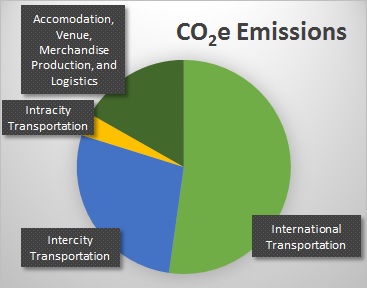When writing a post about the World Cup, I feel like it’s necessary to begin by stating exactly how much of a fan you are. So let the record stand that I am really not that much of a soccer/football fan. But every other person I know is, so I think it’s safe to say that the World Cup is important to us, “us” being the human race. It’s one of the few times so many countries can get together and celebrate, grieve, and play.
Something else that’s important to us is the environment. And a massive international production like the World Cup is bound to have a similarly massive environmental footprint. But thankfully FIFA, the organization that puts on the World Cup, has realized that both the World Cup and the environment are important to us, and has made a commendable effort to minimize and offset their footprint from this summer’s events.
Beginning with the 2006 cup in Germany, FIFA started monitoring their environmental impact. They introduced their Green Goal program the same year, which aims to offset carbon emissions resulting from World Cup events. The program continued with the 2010 World Cup in South Africa and the 2011 Women’s World Cup in Germany. For this year’s World Cup in Brazil, FIFA released a comprehensive Impact Report which estimated the environmental impact of all events and activities directly under their influence or control relating to the World Cup.
By their estimates, FIFA believes the 2014 World Cup will generate 2.9 million tons of greenhouse gas emissions. Not surprisingly, transportation accounts for 83.7% of this number. International transportation (flights to Brazil) brings a whopping 50.6% of their total estimated emissions (with approximately 1.5 million tons CO2e), intercity transportation lays claim to 29.5% (802,397 tons CO2e), and intracity transport accounts for 3.6% (98,464 tons CO2e). That means that accommodations, venues (including electricity usage, temporary facility construction, food and beverage, waste and wastewater, and refrigerant leaking), merchandise production, and logistics all only account for 17.3% (or 489,102 tons CO2e) of the World Cup’s totally footprint—less than the transportation between cities alone.
With international flights responsible for so much of the World Cup’s footprint, what could FIFA realistically do to minimize their impact? They can’t stop people from flying to Brazil. (That does seem to defeat the point, too.) But that hasn’t stopped them from trying to reduce their impact. For starters, they plan to offset 277,000 tons of CO2 emissions for which they claim they are directly responsible, as well as 88,000 tons for the travel emissions of fans. And while several of the sustainable projects begun in preparation for the World Cup didn’t make it to fruition (such as a functioning monorail system and LEED certification for all 12 of the World Cup stadiums), some of the successes include 6 LEED certified stadiums and 2 solar-powered stadiums.
They have also hired over 700 workers to collect waste and recycling, and so far they have collected 22 tons of waste, 90% of which was recyclable aluminum cans. Some of the newly constructed stadiums used up to 20% recycled material, and up to 90% of the construction residues were recycled. The new stadiums cut water consumption by 67% and electricity by 13% yearly. And to top it all off, the environment ministry set up kiosks near stadiums were local organic growers could sell their food to encourage a local food movement.
FIFA and the Brazilian Local Organizing Committee aren’t the only ones aiming for sustainable sport. Japanese fans inspired viewers around the world when, after their team’s loss, they proceeded to clean up their trash from their section of the stadium. And an application called “The Green Passport” helps tourists visiting Brazil for the World Cup learn how to make more sustainable choices while travelling.
FIFA plans to continue their commitment to sustainability past the the this year’s World Cup. They will require bidders for the 2018 and 2020 World Cups to submit a a plan to avoid and minimize environmental impact. Other large sporting events, such as the Olympics and the annual Superbowl in the US, are also beginning to take sustainability seriously. So while the impact of such events is large, the important thing is that the people putting on the events are acknowledging the impact and trying to minimize it. Perhaps one day the competition for the “greenest game” will be just as important as the match itself. And when that day comes, you might just find me sitting down to watch.
By Jessica Edington
Sources:
http://journalrecord.com/2014/06/27/roth-environmental-effect-of-the-world-cup-opinion/
http://www.fifa.com/aboutfifa/socialresponsibility/environmental.html
https://worldcupoffset.fifa.com/en/initiate
http://www.greenbiz.com/blog/2014/07/09/how-green-2014-world-cup
http://blog.theecoexperts.co.uk/how-does-the-world-cup-affect-the-environment
http://www.greenbiz.com/blog/2014/01/14/nfl-planning-greenest-superbowl-ever-again
